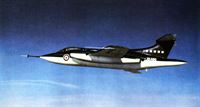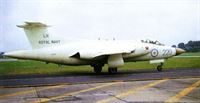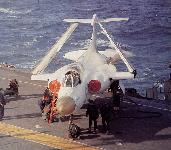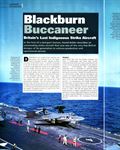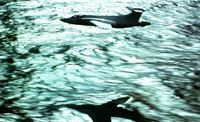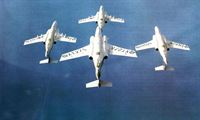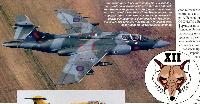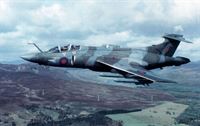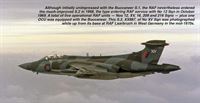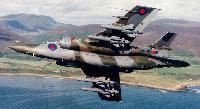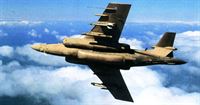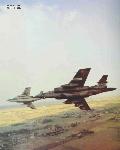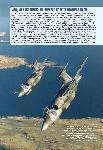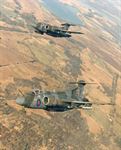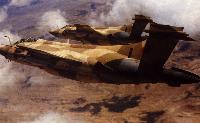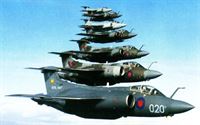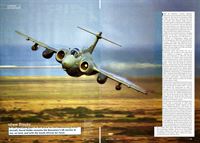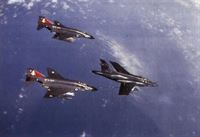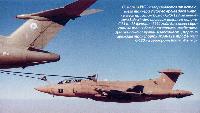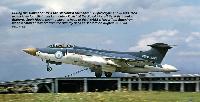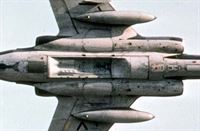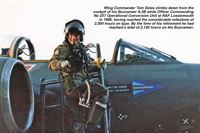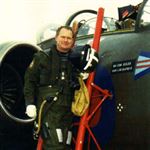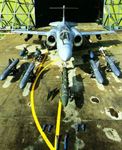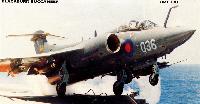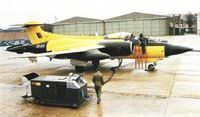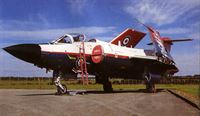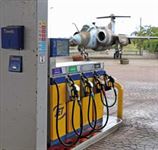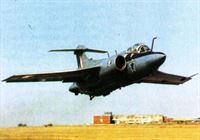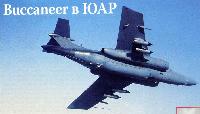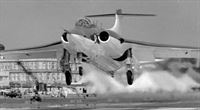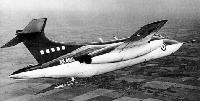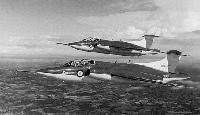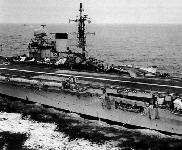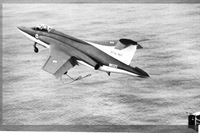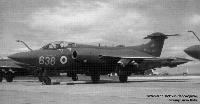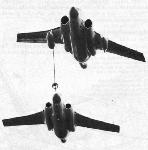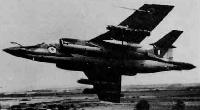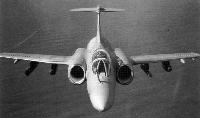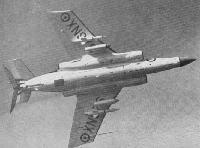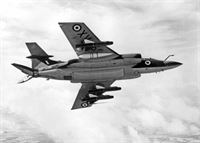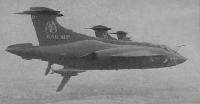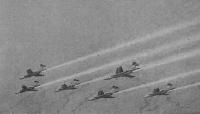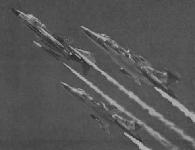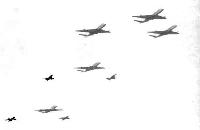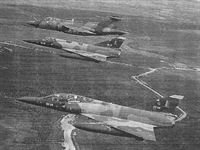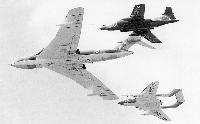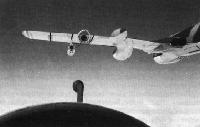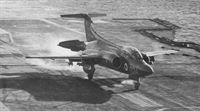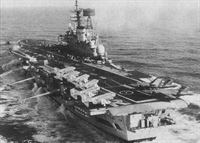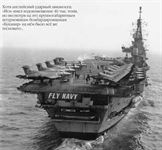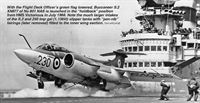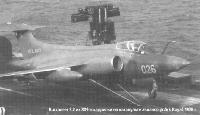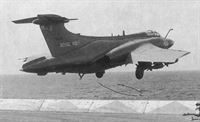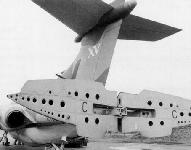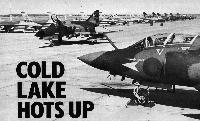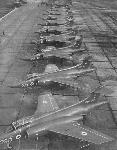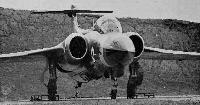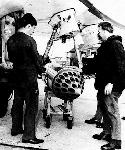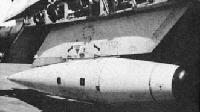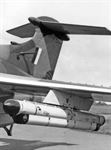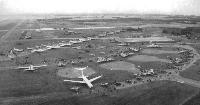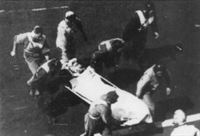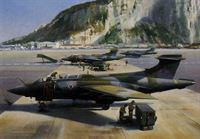
Описание
Страна : Великобритания
Год : 1958
Палубный и сухопутный маловысотный штурмовик с двумя членами экипажа
Blackburn B-103 Buccaneer
В 1962 году фирма "Hawker Siddeley Group" поглотила фирму "Blackburn", которая с мая 1963-го стала ее отделением "Hawker Blackburn Division". В апреле 1965 года название всей компании изменили на "Hawker Siddeley Aviation Ltd". В 1977 году "Hawker Siddeley" слилась с другими британскими предприятиями авиакосмической отрасли, образовав концерн "British Aerospace" (BAe). Поэтому Blackburn B-103 Buccaneer на последних этапах своего существования был известен как изделие и "Hawker Siddeley", и BAe.
Своей долгой эксплуатацией B-103 доказал, что является гораздо лучшей машиной, чем вначале казалось. Он создавался в начале 1950-х годов по спецификации ВМС NA.39 и был первым в мире двухместным палубным скоростным реактивным штурмовиком, летавшим на малых высотах вне зоны видимости вражеских РЛС. В базовой конфигурации самолет характеризовался такими передовыми чертами, как система управления пограничным слоем, раздвижной хвостовой обтекатель, игравший роль и воздушного тормоза, поворотный бомбоотсек, способный нести обычное или ядерное оружие. Такая конструкция бомбового отсека позволяла избегать при сбросе бомб действия на створки высокоскоростного воздушного потока.
В июле 1955 года B-103 запустили в серийное производство, разместив заказ на оценочную партию из 20 самолетов. Предсерийные машины (первый полет состоялся 30 апреля 1958 года) оснащались двумя ТРД de Havilland Gyron Junior DGJ.1 тягой по 31,14 кН. Четвертый самолет имел полное палубное оснащение: складывающиеся консоли крыла и носовую часть, тормозной крюк и узлы крепления к катапульте. Он проходил испытания на пригодность к использованию с авианосца. В октябре 1959 года поступил заказ на 40 Buccaneer S.Mk 1 с двигателями Gyron Junior 101 тягой 31,58 кН. Первый самолет взлетел 23 января 1962-го, а 17 июля ВМС объявили о боеготовности 801-й эскадрильи с Buccaneer, размещенной в январе следующего года на авианосце "Арк Ройял". Buccaneer S.Mk 1 явно не хватало энерговооруженности, поэтому для основного серийного варианта Buccaneer S.Mk 2 был выбран ТРДД Rolls-Royce Spey, более мощный и экономичный, чем двигатель Gyron Junior. Первый из 84 серийных самолетов этой модификации взлетел 5 июня 1964 года. Buccaneer S.Mk 2 обладал увеличенной дальностью по сравнению с S.Mk 1 и был оснащен оборудованием для дозаправки в воздухе. Данный вариант поступил на вооружение морской авиации в октябре 1965-го и был снят с эксплуатации в 1978 году.
Несмотря на то, что Buccaneer Mk 50 предназначался для действий с береговых баз, в 1965 году южно-африканским ВВС поставлялся его полный морской вариант. Эти 16 самолетов в дополнение к тяге обычной силовой установки оснащались твердотопливными ракетными ускорителями Bristol Siddeley BS.605, установленными в задней части фюзеляжа и выдававшими в течение 30 секунд тягу 35,59 кН. Это значительно ускоряло взлет и сокращало взлетную дистанцию. Южно-африканские ВВС списали последние Buccaneer в 1991 году. Buccaneer S.Mk 2 продолжали летать даже после сокращения авианосных сил Великобритании. С 1969 года их из ВМФ передавали в ВВС, в июле 1970 года первой на Buccaneer S.Mk 2 начала летать 12-я эскадрилья. Самолеты ВВС неофициально именовались "переходными S.Mk 2В", затем они получили буквенно-цифровое обозначение Mod 1188, означавшее возможность нести противокорабельную ракету Martel на удлиненных узких пилонах. Некоторые бывшие морские самолеты прошли ряд специальных доработок и именовались Mod 1499. В 1972 году машины, не предназначенные для вооружения ракетами Martel, обозначили S.Mk 2А, в основном они использовались в учебных целях. Большинство модернизированных самолетов обозначили S.Mk 2В, позднее на них ставили дополнительные топливные баки в бомболюке. Были выпущены 43 новых серийных Buccaneer S.Mk 2В, летные испытания которых проводились с 8 января 1970 года. Перед снятием с вооружения остававшиеся во флоте Buccaneer прошли примерно те же модернизации, что и Buccaneer S.Mk 2В. Им присвоили обозначение Buccaneer S.Mk 2С и S.Mk 2D, соответственно, без возможности и с возможностью нести ракету Martel.
7 февраля 1980 года один из Buccaneer потерпел катастрофу. Расследование показало, что она стала результатом усталостного разрушения крыла. Самолетам запретили летать до июля, пока все машины не прошли всестороннюю проверку. Вскоре 216-я эскадрилья была расформирована, и к концу 1981 года данный тип машин оставался только в 12-й эскадрилье в Лоссимуте, 237-й (тренировочной) и 208-й в Хонингтоне. Эти подразделения расформировали в 1983 году, заменив их эскадрильями с Tornado. Но в качестве противокорабельной машины Buccaneer оставался в строю до 1994 года, а в 1991-м он принял участие в войне с Ираком.
ТАКТИКО-ТЕХНИЧЕСКИЕ ХАРАКТЕРИСТИКИ
Blackburn Buccaneer S.Mk 2В
Тип: палубный и сухопутный маловысотный штурмовик с двумя членами экипажа
Силовая установка: два ТРДД Rolls-Royce Spey RB.168-1A Mk 101 тягой по 50,06 кН
Характеристики: максимальная скорость 1040 км/ч на 61 м; начальная скороподъемность 2134 м/мин; практический потолок более 12190 м; дальность полета 3701 км со стандартным вооружением
Масса: пустого самолета 13 599 кг; максимальная взлетная 28123 кг
Размеры: размах крыла 13,41 м; длина 19,33 м; высота 4,97 м; площадь крыла 47,82 м2
Вооружение: до 7258 кг различного подвесного вооружения в бомбоотсеке и на четырех подкрыльевых пилонах, в том числе одна ядерная бомба или четыре обычных 454-кг бомбы внутри фюзеляжа и до 12 454-кг или 24 227-кг бомб, или 4 ПУ с неуправляемыми ракетами, или три противокорабельные ракеты AJ.168 Martel и контейнер с аппаратурой их наведения, или четыре противокорабельные ракеты Sea Eagle на внешних подвесках
- Описание
Фотографии
-
Air International 1984-08 / Model enthusiast
Регистрационный номер: XK534 [3] Blackburn Buccaneer XK534. one of the Development Batch S Mk 1s, was the first to appear in the all-white anti-radiation finish and is shown here in the markings of 700Z Squadron, the intensive trials unit, at Lossiemouth.
-
Мир Авиации 1997-01 / С.Цветков - Карманный линкор британской авиации /Авиадосье/ (1)
Регистрационный номер: XN953 Buccaneer S.1 XN953 из 800 эскадрильи, авианосец Eagle, 1964г. Хотя все "Бакэниры" выходили с завода полностью белыми, на службе многие (но не все) получили темно-серо-голубую окраску сверху.
-
Air International 1984-08 / Model enthusiast
Регистрационный номер: XN981 Buccaneer S Mk 2 XN981, in mid-'sixties gloss finish of extra dark sea grey and white. The markings are those of 801 Naval Air Squadron, as operating from HMS Victorious.
-
Air International 1984-08 / Model enthusiast
Регистрационный номер: XV340 Buccaneer S Mk 2 XV340 in gloss extra dark sea grey finish overall, and the markings of 809 NAS, home-based at Lossiemouth.
-
Мир Авиации 1997-01 / С.Цветков - Карманный линкор британской авиации /Авиадосье/ (1)
Регистрационный номер: XV361 Buccaneer S.2 XV361 из 809 эскадрильи, авианосец Ark Royal, 1976г. С 1966г. до конца карьеры палубные "Бакэниры" служили темно-серо-голубыми со всех сторон.
-
Мир Авиации 1997-01 / С.Цветков - Карманный линкор британской авиации /Авиадосье/ (1)
Регистрационный номер: XV333 Buccaneer S.2B XV333 из 16 эскадрильи, авиабаза Лаарбрюк (английские ВВС в ФРГ), 1979г. В 1977г. "Бакэниры" Королевских ВВС получили на всех поверхностях двуцветный серо-зеленый камуфляж (до этого низ фюзеляжа и крыла красился светло-серым).
-
Air International 1984-08 / Model enthusiast
Регистрационный номер: XW536 Buccaneer S Mk 2B XW536 in service with No 16 Squadron. RAF Germany, in the mid-'seventies, in the standard RAF camouflage of matt dark green, dark sea grey and light aircraft grey.
-
Air International 1984-08 / Model enthusiast
Регистрационный номер: XV352 [6] Buccaneer S Mk 2A XV352 was one of the aircraft of No 208 Squadron, RAF, that participated in Red Flag exercises in the USA in 1977, with matt dark earth and light stone over the standard camouflage.
-
Мир Авиации 1997-01 / С.Цветков - Карманный линкор британской авиации /Авиадосье/ (1)
Регистрационный номер: XX901 [2] Buccaneer S.2B XX901 во время операции "Буря в пустыне". Авиабаза Мухаррак, Бахрейн, февраль 1991г.
-
Air International 1984-08 / Model enthusiast
Buccaneer S Mk 50 "414" of No 24 Squadron, SAAF, in the gloss finish of dark sea grey upper surfaces and PRU blue undersides.
-
Мировая Авиация 66
HS Buccaneer S.Mk 50. Начиная с 1966 года, Южная Африка получила шестнадцать Buccaneer, вошедших в состав 24-й эскадрильи. Эти самолеты имели достаточную дальность полета и боевую нагрузку, чтобы атаковать позиции повстанцев глубоко на территории Анголы, используя 450-кг бомбы и неуправляемые ракеты.
-
Мир Авиации 1997-01 / С.Цветков - Карманный линкор британской авиации /Авиадосье/ (1)
Buccaneer S.50 414 из 24 эскадрильи южно-африканских ВВС, 1974г.
-
Мировая Авиация 47
Buccaneer S.Mk 50. Свой первый боевой вылет самолеты Buccaneer ВВС ЮАР совершили 4 мая 1978 года в ходе операции против Анголы. Аналогичные рейды позже совершались в Замбии с нанесением ударов при помощи НАР и управляемых ракет Nord AS30 французского производства.
-
Air International 2007-02 / D.Hobbs - Blackburn Buccaneer /Legends of aviation/ (1)
Регистрационный номер: XK486 [6] As can be seen from this rare colour image of the prototype NA.39, XK486, there were very few design changes between it and the final production Buccaneer. In spite of a demanding specification, the designers at Blackburn Aircraft 'got it right first time'
-
Aviation Historian 24 / T.Eeles - Brute force & innovation
Регистрационный номер: XK534 [3] Pre-production NA.39 XK534 of No 700Z NAS, coded LM/683, rolls on to the “piano keys” at Farnborough before its display at the 1961 SBAC show. The air intakes of the S.1 ’s Gyron Junior engines were considerably smaller than those required for the later more powerful Speys fitted in the S.2 variant.
-
Air International 2007-02 / D.Hobbs - Blackburn Buccaneer /Legends of aviation/ (1)
Регистрационный номер: XN924 [2] No.809 NAS Buccaneers.1 XN924/220, finished overall in the gloss white anti-radiation paint scheme then current for nuclear strike aircraft.
-
Air International 2007-02 / D.Hobbs - Blackburn Buccaneer /Legends of aviation/ (1)
Регистрационный номер: XK487 [5] One of the 20 development batch Buccaneers, XK487, was used by Ferranti as a flying test-bed for the TSR2 radar. It was photographed at a 'snowy' Holme-on-Spalding Moor in 1963.
-
Aviation Historian 24 / T.Eeles - Brute force & innovation
An unidentified early S.1 is prepared for a flight during deck trials. Some S.1s were painted in an overall white anti-nuclear-flash colour scheme, similar to that used on V-Force aircraft, including a pale pink and blue roundel, with the radome left unpainted. Because of its curvaceous area-ruled fuselage, the Buccaneer became known as the "banana jet”, these white-painted examples being dubbed "peeled bananas"!
-
Мировая Авиация 47
Buccaneer из 801-й эскадрильи на летной палубе британского авианосца "Арк Роял" во время первого испытательного боевого похода перед припиской эскадрильи к авианосцу "Викториз". Ядром 801-й эскадрильи стали экипажи эскадрильи № 700Z, аттестованные для полетов на Buccaneer в июле 1962 года. Благодаря складным консолям крыла и раздвижным аэродинамическим тормозам самолет помещался на небольших палубах британских авианосцев.
-
Мировая Авиация 47
Хотя большинство из 193 британских и 16 южноафриканских Buccaneer пошло на слом или оказалось в гражданских авиамузеях в Элгине и Макклесфилде, несколько машин пополнили экспозиции военных музеев. Первый из них - Buccaneer (S.Mk 1) - попал в Музей авиации флота на авиабазе Королевского ВМФ в Йовилтоне. Самолет, служивший в 801-й и 809-й эскадрильях ВМФ, показан в раннем варианте окраски - темно-серо-голубой сверху и белый снизу.
-
Air International 2007-02 / D.Hobbs - Blackburn Buccaneer /Legends of aviation/ (1)
This Buccaneer S.1 of 800 NAS is about to be launched from the waist catapult of HMS Eagle. The bridle is tensioned and the blast deflector has been raised. The flight deck officer has his green flag lifted and waits for the pilot to signal that he is ready to be launched.
-
Air International 2007-02 / D.Hobbs - Blackburn Buccaneer /Legends of aviation/ (1)
A Buccaneer S.1 of 809 NAS. seen in its element, at low level over the sea and at high speed.
-
Aviation Historian 24 / T.Eeles - Brute force & innovation
Регистрационный номер: XN960 Buccaneer S.1 XN960 demonstrates the type’s highly effective split airbrake as it comes in to land at Le Bourget during the 1963 Paris Air Salon. The airbrakes were extensively tested and modified during the Buccaneer’s trials programme, with strakes of various sizes added above and below the petals until the most effective configuration was found.
-
Air International 2007-02 / D.Hobbs - Blackburn Buccaneer /Legends of aviation/ (1)
Регистрационный номер: XN929 [2], XN931, XN933 [2], XT275 Spot the odd man out. No.736 NAS's first Buccaneer S.2, XT275, is flying in the number four 'box' position as the squadron's instructors practise aerobatics in 1967. The photograph illustrates the larger air intakes needed by the S.2 for its Rolls-Royce Spey engine and its faired wingtips.
-
Авиация и Космонавтика 2025-03 / М.Никольский - Авиационное тактическое ядерное оружие (4)
«Буканир» из состава 15-й эскадрильи в полете над Германией, 1983 г.
-
Мировая Авиация 47
В течение 11 лет в Германии самолеты Buccaneer поддерживались в состоянии готовности к нанесению ядерного удара. На снимке самолет S.Mk 2 из 16-й эскадрильи, базировавшейся в Лаарбрухе, летит на малой высоте над сельской местностью.
-
Мировая Авиация 47
Этот Buccaneer S.Mk 2B с эмблемой 12-й эскадрильи в виде лисьей морды несет обычное противокорабельное вооружение. Эскадрилья получила известность под названием "Shiny Twelve" еще с тех пор как стала использовать отполированные до блеска истребители-бипланы Fairey Fox. Экипажи "Bucc" продолжили традицию, полируя кромки воздухозаборников своих самолетов.
-
Aeroplane Monthly 1994-05 / M.Oakey - Grapevine
Регистрационный номер: XX899 Hawker Siddeley Buccaneer S.2B XX899 low over Lossiemouth on March 5, 1994, marking the type’s retirement from service after 33 years with the RAF and FAA. Painted up for the occasion in a variety of former Buccaneer unit schemes, including Nos 12, 16, 216, 260 and 809 Sqns, the last nine aircraft made their final flights on March 27.
-
Air International 2007-12 / R.Whitford - Faster than sound /Technology/
A classic example of an aircraft incorporating area ruling was the Blackburn Buccaneer. Note the large fuselage bulge aft of the wing and the rear-fuselage clam-shell airbrakes. These features reduced the drag at the high subsonic speeds that the Buccaneer was designed to operate at.
-
Aviation Historian 24 / T.Eeles - Brute force & innovation
Регистрационный номер: XX887 [2] XV эскадрилья британских ВВС получила Buccaneer в 1970 году. До 1983-го она летала на S.Mk 2В с неядерным вооружением и размещалась на авиабазе Лаарбрух в ФРГ.
Although initially unimpressed with the Buccaneer S.1, the RAF nevertheless ordered the much-improved S.2 in 1968, the type entering RAF service with No 12 Sqn in October 1969. A total of five operational RAF units - Nos 12, XV, 16, 208 and 216 Sqns - plus one OCU was equipped with the Buccaneer. This S.2, XX887, of No XV Sqn was photographed while up from its base at RAF Laarbruch in West Germany in the mid-1970s. -
Air International 1982-08 / M.Byrne - Buccaneer: the 15-year stop-gap
Buccaneers serving with Nos 15 and 16 Squadrons in Germany have been adapted to carry Paveway laser-guided bombs, as seen here.
-
Air International 2007-02 / D.Hobbs - Blackburn Buccaneer /Legends of aviation/ (1)
Регистрационный номер: XV863 Befitting their low-level maritime role, Buccaneers began receiving an overall extra dark sea grey colour scheme in 1968, as displayed on S.2, XV863/020, of 809 NAS. This squadron operated Buccaneer S.1s during 1963-65 and was re-formed with S.2s in January 1966.
-
Мировая Авиация 47
Buccaneer из 12-й эскадрильи с четырьмя ракетами Sea Eagle во время учебно-тренировочного полета из Лоссимауса. Ракеты Sea Eagle реализовывала принцип "запустил - забыл", позволяя самолетам Buccaneer оставаться на вооружении даже в XXI веке. Однако предпочтение было отдано самолетам Tornado GR.Mk 1B из-за более выгодного соотношения стоимости и эффективности при проведении боевых операций.
-
Air International 2007-03 / D.Hobbs - Blackburn Buccaneer /Legends of aviation/ (2)
Twelve Buccaneers were deployed to Muharraq during the Gulf War, initially to provide laser designating support for Tornado GR.Is. Later, when the Tornados had been equipped with TIALD, Buccaneers carried a Paveway bomb and undertook self-designating attacks. This aircraft carries a Pave Spike pod and Sidewinder on the port wing, and an AN/ALQ-101(V) jamming pod under the starboard wing.
-
Aviation Historian 40 / C.Gibson - Pirates of the South Atlantics
Регистрационный номер: XX895 [2] The primary weapon to be used for the operation was the AJ.168 TV-Martel air-to-surface missile carried by a Buccaneer S.2B. Here XX895 is carrying TV-Martels on the port inner and starboard outer pylons, an AS.37 anti-radiation variant on the port outer pylon and the datalink pod for the TV-Martel on the starboard inner pylon.
-
Air International 1982-08 / M.Byrne - Buccaneer: the 15-year stop-gap
Регистрационный номер: XX901 [2] The example seen here is from the No 208 Squadron, RAF, one of two now operating the Buccaneer in the UK.
-
Jane's All the World Aircraft 1980 / Encyclopedia of Aviation - Aircraft A-Z - v3
Hawker Siddeley Buccaneer S.2Bs.
-
Air International 2007-03 / D.Hobbs - Blackburn Buccaneer /Legends of aviation/ (2)
A pair of 12 Sqn Buccaneers investigate a SAM Kotlin class destroyer during maritime Exercise Lime Jug in the Mediterranean in November 1970. Strict rules dictated that 'aircraft must not approach closer than 400 yards or make aggressive manoeuvres'.
-
Aviation Historian 41
Регистрационный номер: XZ432 [4] Tom Eeles in Buccaneer S.2B XZ432 leads a pair formation over the west coast of Scotland in 1987.
-
Aviation Historian 5 / B.Dunnell - Falklands confidential
Регистрационный номер: XZ432 [4] Tough as nails and in a class of its own at low level, the Blackburn (later Hawker Siddeley) Buccaneer may well have proved an invaluable maritime strike asset during the Falklands War, but in the event it was not called upon to serve in the conflict. Here a pair of Buccaneer S.2Bs of No 237 Operational Conversion Unit are captured in the type’s element - fast and low.
-
Aviation Historian 24 / T.Eeles - Brute force & innovation
Регистрационный номер: XZ432 [4] The author leads a two-aircraft formation in S.2B XZ432 during a photographic sortie over the west coast of Scotland, near Oban, on March 11, 1987. Tom enjoyed three tenures with No 237 OCU, a specialist Buccaneer training unit: as a QFI during 1971-72; CFI 1977-79 and OC 1984-87.
-
Aviation Historian 24 / T.Eeles - Brute force & innovation
A two-Buccaneer formation over Scotland, led by Gp Capt Tom Eeles, who reveals in this issue what the type was like to fly.
-
Aviation Historian 40 / C.Gibson - Pirates of the South Atlantics
Регистрационный номер: XV352 [6] A two-aircraft formation of Buccaneers of No 237 Operational Conversion Unit, led by Gp Capt Tom Eeles in the nearest, in March 1987.
-
Aviation Historian 24 / T.Eeles - Brute force & innovation
Регистрационный номер: XV352 [6] Another photograph of the author’s two-aircraft formation of No 237 OCU S.2s during a photo sortie from Lossiemouth in March 1987. Nearest the camera this time is XV352, which was later used as part of a nine-aircraft formation for a final photo-call for the Buccaneer before the type was retired from RAF service in March 1994.
-
Air International 1982-08 / M.Byrne - Buccaneer: the 15-year stop-gap
In desert camouflage for their participation in "Red Flag 77-9' these Buccaneers of No 208 Squadron are about to descend into the weapon ranges near Salt Lake City in Utah after a high-level transit from Nellis AFB.
-
Air International 1982-08 / M.Byrne - Buccaneer: the 15-year stop-gap
A trio of Buccaneer S Mk 2s of No 208 Squadron, RAF, demonstrate some low-level exercises over British ranges;
-
Air International 2007-03 / D.Hobbs - Blackburn Buccaneer /Legends of aviation/ (2)
As there were no dual-control Buccaneers, pilot training was carried out on Hunter T.7/8s fitted with the Buccaneer instrument panel in the left-hand seat.
Другие самолёты на фотографии: Hawker Hunter T - Великобритания - 1955
-
Air International 2007-03 / D.Hobbs - Blackburn Buccaneer /Legends of aviation/ (2)
Регистрационный номер: XX894 For the final farewell in March 1994, seven aircraft received the markings of the squadrons which flew the Buccaneer. XX894 was painted in the markings of 809 NAS to represent the Royal Navy Buccaneer squadrons. The aircraft are stepped up in numerical order of squadrons, 12, XV, 16, 208, 216 and 237 OCU.
-
Air International 2007-03 / D.Hobbs - Blackburn Buccaneer /Legends of aviation/ (2)
Регистрационный номер: XV352 [6] Seen in its element at low-level and high speed, Gulf War veteran XV352, 'Tamdhu' was photographed over the Tain Weapons Range, Scotland in March 1994.
-
Мировая Авиация 47
Служба в боевых частях закончилась для самолетов Buccaneer 31 марта 1994 года, когда для борьбы с морскими целями англичане выбрали Tornado. Многие ветераны ВВС, летавшие на "Bucc", глубоко переживали их уход, утверждая, что для решения таких задач они были куда лучше, чем заменившие их машины. Незадолго до вывода из боевых частей Buccaneer получили новую светло-серую окраску, розово-голубые опознавательные знаки и белые номера. Многие считали, что такая схема больше соответствует затянувшейся "моде" на серый цвет в авиации, чем реальным боевым требованиям.
-
Мировая Авиация 186
Бельгийский Mirage 5BA из 8-й эскадрильи сопровождает Buccaneer британских ВВС. 6 января 1991 года 75 бельгийских Mirage были переброшены в Эрхак, Турция, на случай, если иракские войска атакуют Турцию.
Другие самолёты на фотографии: Dassault Mirage 5 / Mirage 50 - Франция - 1967
-
Air International 1995-11 / D.Allport - History of In-Flight Refuelling
Buddy-buddy refuelling is demonstrated here by a Royal Navy Buccaneer 'tanker' of 809 Squadron refuelling a Phantom FG.1 of 892 Squadron from HMS Ark Royal.
Другие самолёты на фотографии: McDonnell Douglas Phantom FG.Mk I / FGR.Mk II - США - 1964
-
Мировая Авиация 164
После фолклендской войны парк Victor получил новую окраску, которая продержалась до завершения карьеры Victor в 1993 году. На фотографии - самолет из 55-й эскадрильи передает топливо паре Buccaneer S.Mk2 из 208-й эскадрильи.
Другие самолёты на фотографии: Handley Page Victor / H.P.80 - Великобритания - 1952
-
Air International 2008-07 / A.Brookes - Handley Page Victor /Aircraft profile/
Originally ordered as a B.1, XH672 was upgraded to B.2 standard on the production line. It entered service in June 1960, and was converted four years later as an SR.2 model and subsequently as a K.2, serving with 55 and 57 Squadrons. It is seen here in September 1993 in the markings of 55 Squadron, about to refuel a Tornado and Buccaneer. Two months later, on November 30, this aircraft made the final flight by a Victor.
Другие самолёты на фотографии: Handley Page Victor / H.P.80 - Великобритания - 1952Panavia Tornado IDS (GR) - International - 1974
-
Мировая Авиация 148
Регистрационный номер: XV348 [2] Штурмовик Buccaneer из 2-й эскадрильи, несущий контейнер НАР SNEB под левой консолью крыла, дозаправляется от Victor K.Mk 1A из 57-й эскадрильи. Всего был построен 31 самолет-заправщик раннего образца, включая один самолет с тремя точками дозаправки для испытаний, шесть двухточечных самолетов, переделанных из машин B.Mk 1A (служивших в 55-й эскадрилье), 10 трехточечных на базе машин B.Mk 1 (для 214-й эскадрильи) и 74 трехточечных на базе самолетов B.Mk 1A (для 55-й и 57-й эскадрилий). Важной особенностью самолетов Victor была собственная штанга дозаправки топливом, резко увеличивавшая его возможности.
Другие самолёты на фотографии: Handley Page Victor / H.P.80 - Великобритания - 1952
-
Мировая Авиация 47
Регистрационный номер: XV352 [6] Самолет XV352 заправляется от летающего танкера Victor во время боев в Ираке, неся при этом бомбу CPU-123 (заменившую Sidewinder) на левом внешнем пилоне. С 21 по 28 февраля 1991 года Buccaneer сбросили 48 таких бомб с лазерным наведением. Два экипажа получили известность, поразив иракские транспортник Ан-12 и трофейный C-130 на аэродроме Шейка Мейхар.
Другие самолёты на фотографии: Handley Page Victor / H.P.80 - Великобритания - 1952
-
Мировая Авиация 47
"Едоки грязи". Buccaneer впервые прибыли на американскую авиабазу Неллис в 1977 году для участия в учениях по программе "Red Flag". 10 самолетов 208-й эскадрильи предприняли трансатлантический перелет. Их участию в маневрах придавалось большое значение, поэтому четыре машины специально перекрасили в пустынный камуфляж (как на снимке). Боевые возможности Buccaneer на малых высотах произвели на американцев благоприятное впечатление. Англичане наносили удары на высоких скоростях и на высотах менее 30 м, проносясь в тучах пыли, за что американцы в шутку прозвали их "Dirt Eaters" ("Едоки грязи"). Повторный визит на базу Неллис англичане нанесли в 1980 году, когда для участия в маневрах прибыли 15-я и 16-я эскадрильи. Однако 7 февраля Buccaneer из 15-й эскадрильи разбился при заходе на цель. Причиной катастрофы оказалось усталостное разрушение металла в конструкции крыла. Это послужило сигналом для отзыва Buccaneer с учений и тщательной проверки всего парка этих самолетов в Королевских ВВС. Вскоре стало ясно, что многие машины сильно изношены и требуют капитального ремонта, а некоторые вообще пришлось списать.
-
Мировая Авиация 47
На этой редкой фотографии Buccaneer летит рядом с одним из учебных самолетов Hunter, в кабине которого установлено аналогичное Buccaneer приборное оборудование. Поскольку ни один Buccaneer не выпускался в учебном варианте с двойным управлением, курсанты могли отработать полеты под контролем инструктора на таких учебных Hunter, прежде чем выполнить первый самостоятельный полет на реальном боевом самолете.
Другие самолёты на фотографии: Hawker Hunter T - Великобритания - 1955
-
Aviation Historian 15 / R.White - The New Frontier
Регистрационный номер: XK526 [3] Макет палубы авианосца и катапульты в НИЦ авиации Великобритании в Бедфорде сыграли важную роль в программе Buccaneer. На снимке - первый S.Mk 2 во время испытаний, он вооружен блоками из 24 ракет (на вооружение не приняты).
During the summer of 1964 the Blackburn Buccaneer S.2 prototype XK526 was used extensively for “Minimum Launching Trials” at the Royal Aircraft Establishment at Bedford. Geoff Higgs, soon to become head of the A&AEE’s Naval Test Squadron, made a catapult take-off from the dummy deck at Bedford on August 25, 1964. -
Aviation Historian 15 / R.White - The New Frontier
Регистрационный номер: XK526 [3] Buccaneer S.2 XK526 during a dummy deck take-off at RAE Bedford.
-
Мировая Авиация 55
Регистрационный номер: XN974 [3] XN974 - первый Buccaneer S.Mk 2. Этот вариант стоял на вооружении 800-й, 801-й, 803-й и 809-й эскадрилий. Самолеты действовали с авианосцев "Арк Ройял", "Игл" и "Викториес".
-
Мировая Авиация 47
Регистрационный номер: XT270 Buccaneer XT270 из 12-й эскадрильи специально для фотосъемки запускает неуправляемые ракеты (НАР) SNEB. Эти ракеты считались вспомогательным вооружением и были сняты с производства в 1970-е годы, после чего основным средством поражения стали ракеты Martel.
-
Авиация и Космонавтика 2025-03 / М.Никольский - Авиационное тактическое ядерное оружие (4)
Бомбоотсек «Буканира», доработанный под размещение атомной бомбы WE-177
-
Aeroplane Monthly 1994-04 / 1994 UK Aircraft Collections and Museums Guide
Регистрационный номер: XN974 [3] A 1971 photo of Buccaneer XN974, now in the Yorkshire Air Museum.
-
Авиация и Космонавтика 2025-03 / М.Никольский - Авиационное тактическое ядерное оружие (4)
«Буканир» S.2А из состава 12-й эскадрильи
-
Air International 1981-08 / J.Chance - Cold lake hots up
The hulk of a Sherman tank hidden among trees provides a typical example of targets for specific tasks set for the Maple Flag participants. They included eight Buccaneer S Mk 2s from No 208 Squadron RAF taking part in a major exercise for the first time since their grounding last year.
-
Aviation Historian 24 / T.Eeles - Brute force & innovation
Wing Commander Tom Eeles climbs down from the cockpit of his Buccaneer S.2B while Officer Commanding No 237 Operational Conversion Unit at RAF Lossiemouth in 1986, having reached the considerable milestone of 2,000 hours on type. By the time of his retirement he had reached a total of 2,185 hours on the Buccaneer.
-
Air International 2007-03 / D.Hobbs - Blackburn Buccaneer /Legends of aviation/ (2)
Wg Cdr Tom Eeles photographed when he was the Officer Commanding 237 OCU at Lossiemouth in 1984 -87.
-
Air International 1983-09 / P.Jackson - Ocean Safari ...
A Buccaneer of No 12 Squadron carrying the TV Airborne Trainer (TV AT) pod wider the starboard wing, AN/ALQ-101 ECM to port and practice bomb carriers under both wings.
-
Авиация и Космонавтика 2025-03 / М.Никольский - Авиационное тактическое ядерное оружие (4)
«Буканир» S.2В из состава 15-й эскадрильи, 1970-е гг.
-
Мировая Авиация 144
В годы холодной войны войска стран НАТО и ОВД находились в состоянии высокой боевой готовности. Для самолетов сооружались и такие ангары - на фотографии в нем укрыт Buccaneer.
-
Air International 2007-03 / D.Hobbs - Blackburn Buccaneer /Legends of aviation/ (2)
One of the Buccaneer's great strengths was its ability to carry a heavy weapon load over great distances. This is just some of the weaponry that the Buccaneer could deliver. Clockwise from the front, practice bombs, an anti radar Martel, (note its rear fins and the main wings lying on the ground beside it), Sea Eagles, 1,000lb iron bomb, Paveway II LGB, 1,000lb bomb, Sidewinder and Sea Eagles. From port to starboard the aircraft is carrying a practice bomb dispenser, Pave Spike laser designator, practice bomb dispenser, and AN/ALQ-101(V) jamming pod. A notable omission is the WE177 nuclear weapon which, at the time the photo was taken, was still in service and an unclassified photo of it was not possible.
-
Air International 1990-11 / Talkback
Регистрационный номер: XW543 [2] The Buccaneer S Mk 2B XW543 is being used at RAF Leuchars for trials of a new grey finish that combines medium sea grey on the upper surfaces with camouflage grey (previously known as Barley grey, after its originator P J Barley) for the undersurfaces except the bomb door, which remains medium sea grey. The Buccaneer was photographed by Tom Ross at Abingdon during August 1990.
-
Air International 2007-03 / D.Hobbs - Blackburn Buccaneer /Legends of aviation/ (2)
Steam envelopes an 809 NAS Buccaneer about to be launched from the waist catapult of HMS Ark Royal in October 1978. Note the up-elevator setting and nose-high attitude as the strop is tensioned.
-
Мировая Авиация 46
Вооруженный бомбами, самолет S.Mk 2D из 809-й эскадрильи сфотографирован в момент взлета с авианосца "Арк Ройял". Чтобы достигнуть достаточного угла атаки крыла при взлете с короткой катапульты, Buccaneer с помощью замково-стопорной системы устанавливался в положении с приподнятым носом.
-
Air International 1982-08 / M.Byrne - Buccaneer: the 15-year stop-gap
Регистрационный номер: XW986 [4] Several Buccaneers have been used for research and other special duties, including weapon research and development at the RAE.
-
Мировая Авиация 47
Регистрационный номер: XW986 [4] Самолет XW986 использовался Королевским авиационным НИЦ (ныне Управление исследований и оценок МО, DERA). Огромные цифры на створках бомбоотсека были нанесены по ошибке, когда офицер Министерства обороны написал серийный номер машины на чертеже прямо поверх предполагаемой схемы окраски самолета.
-
Air International 1996-06 / Talkback
Регистрационный номер: ZU-AVI [4], XW988 [4] Buccaneer S.2B ZU-AVI (XW988) being prepared for departure from A&AEE Boscombe Down to Exeter Airport on April 19, 1996. It was delivered to its new owner, Mike Beachyhead in South Africa during early May.
-
Aeroplane Monthly 1996-07 / M.Oakey - Vintage news
Регистрационный номер: ZU-AVI [4], XW988 [4] Former Aircraft & Armament Experimental Establishment/Defence Testing & Evaluation Organisation Buccaneer S.2B ZU-AVI (XW988) was due to leave the UK for South Africa during May 1996. It is seen here about to depart from Boscombe Down for Exeter on April 19.
-
Aeroplane Monthly 1997-06 / M.Oakey - Vintage news
Регистрационный номер: ZU-BCR [3], XW987 [3] Another fast jet recently exported to South Africa for Mike Beachyhead, former RAE/A&AEE/DTEO Buccaneer S.2B ZU-BCR (ex XW987), is seen here at Boscombe Down in mid-March 1997 before departing for Africa on April 1 via a temporary base at St Mawgan.
-
Aeroplane Monthly 1999-11
Регистрационный номер: XW986 [4] Buccaneer S.2B XW986 was among the static line-up at Delta Jets’ Open Day at Kemble on August 30, 1999. Airworthy participants included Hunter, Canberra and Meteor F.8.
-
Мировая Авиация 47
Три самолета Buccaneer были переданы в НИЦ Королевской авиации для проведения различных исследований в интересах ВВС. Первоначально они несли желто-зеленую окраску, но позже два самолета, один из которых на снимке, перекрасили в красно-бело-черный "анти-камуфляж". Эти надежные машины участвовали во многих экспериментах, прежде чем вернулись в боевые подразделения.
-
Air Pictorial 2002-05
Регистрационный номер: XX897 The Bournemouth Aviation Museum at Hurn has received some new arrivals recently, including HS Buccaneer XX897 with an unusual radar trials nose. It also wears the livery of locally-based European Aviation which sponsored its restoration.
-
Aeroplane Monthly 1993-03 / M.Oakey - Grapevine
Регистрационный номер: XW547 Newly-arrived Blackburn Buccaneer S.2 XW547 at Cosford Aerospace Museum on January 20, 1993. Apparently the veil on the Guinness Girl nose-art was applied in the UK!
-
Aviation Historian 33 / P.Davidson - Off the Beaten Track...
Регистрационный номер: XW530 [3] New customers visiting the petrol station on the A491 outside Elgin get more "Jet” than perhaps they were anticipating, when confronted by Buccaneer XW530 close to the station forecourt. To find it on Google Earth enter the co-ordinates 57°39'46.8"N 3°18'43.8"W.
-
Aeroplane Monthly 2000-01 / M.Oakey, T.Harmsworth - News
Регистрационный номер: ZU-BCR [3], XW987 [3] Keeping it low after take-off, a tradition for all Buccaneer pilots.
-
Aeroplane Monthly 2000-02 / M.Dereta - Thunder over the Cape /Classic jet air-to-air/
Регистрационный номер: ZU-AVI [4], XW988 [4] At uncharacteristically high altitude ZU-AVI displays its Coke-bottle-shaped fuselage. During flights the client becomes a fully integrated member of the crew. All the aircraft carry a small Shell Oil sponsorship logo.
-
Air International 2007-03 / D.Hobbs - Blackburn Buccaneer /Legends of aviation/ (2)
Регистрационный номер: ZU-AVI [4], XW988 [4] Thanks to Mike Beachyhead, two Buccaneers (XW987 and XW988) survive in airworthy condition at Thunder City, Cape Town. ZU-AVI/XW988 is seen here against the CapeTown backdrop.
-
Aeroplane Monthly 2000-02 / M.Dereta - Thunder over the Cape /Classic jet air-to-air/
Регистрационный номер: ZU-BCR [3], XW987 [3] The three stars of Mike Beachyhead’s Thunder City fleet in formation off the South African coast at Cape Town. The aircraft are not only available for “air experience flights” but can be hired for film work and specialist training; even SAAF test pilots sometimes use them for the latter.
Другие самолёты на фотографии: English Electric / BAC Lightning T.4 / T.5 - Великобритания - 1959Hawker Hunter T - Великобритания - 1955
-
Air International 2007-03 / D.Hobbs - Blackburn Buccaneer /Legends of aviation/ (2)
One of the 16 Buccaneers.50s delivered to the SAAF. This 24 Sqn aircraft is seen in an unusually 'clean' configuration, without underwing conformal fuel tanks or weapons.
-
Мировая Авиация 47
В течение примерно 10 лет, начиная с 1978 года, Buccaneer ВВС ЮАР действовали против намибийских повстанцев, базировавшихся в приграничных районах Анголы. Об этих операциях известно очень мало, но можно предположить, что "Bucc", вооруженные НАР SNEB, играли в них важную роль.
-
Air Enthusiast 1973-03 / ??? - Winged springbok: ... then South African Air Force today
One of No 24 Squadron's Buccaneers.
-
Air International 1982-08 / M.Byrne - Buccaneer: the 15-year stop-gap
The prototype Buccaneer in the Experimental Department at Brough "looking like an aircraft but full of holes that wanted filling with vendor items ”.
-
Air International 1982-08 / M.Byrne - Buccaneer: the 15-year stop-gap
The Buccaneer prototype ready to begin taxying trials at Brough (with five Beverleys behind)
Другие самолёты на фотографии: Blackburn Beverley / B-101 - Великобритания - 1950
-
Air Pictorial 1986-01 / J.Rawlings - Blackburn's Buccaneer (1)
Регистрационный номер: XK488 Initially the Buccaneer was powered by two D.H. Gyron Juniors. XK488, the third NA.39, served as the engine development aircraft at Hatfield
-
Air Pictorial 1959-09
NA.39 strike aircraft
-
Air International 1982-08 / M.Byrne - Buccaneer: the 15-year stop-gap
Регистрационный номер: XK524 [2], XK525 Six of the development batch aircraft at Holme-on-Spalding Moor. As seen here, the tailplane-to-fin fairing and the strokes on the fuselage-end airbrakes underwent considerable development.
-
История Авиации 37 / П.Каминский - Брошенный меч империи /Не вставшие в строй/ (1)
Первый взлёт прототипа «Буканира».
-
Air Pictorial 1986-01 / J.Rawlings - Blackburn's Buccaneer (1)
Регистрационный номер: XK486 [6] On 30th April 1958 Derek Whitehead took XK486, the first Blackburn N.A.39, into the air on its maiden flight from the R.A.E. airfield at Thurleigh, Beds Seen on final approach, the aircraft has the original air brakes and instrumented nose probe
-
Мировая Авиация 87
Регистрационный номер: XK486 [6] 30 апреля 1958г.: первый полет выполнил разработанный по заказу британского Адмиралтейства прототип ударного морского самолета Blackburn NA.39 (позже Buccaneer).
As the prototype Blackburn NA.39 banks it clearly shows the area-ruled fuselage and the split tail air brakes. -
Мировая Авиация 46
Регистрационный номер: XK487 [5], XK489 Второй (XK487, на заднем плане) и четвертый (XK489, на переднем плане) прототипы Buccaneer во время перелета на авиасалон в Фарнборо в сентябре 1960 года.
-
Aviation Historian 11 / K.Hayward - High Anxiety
Регистрационный номер: XK486 [6], XK487 [5], XK490 [2] Flying from Blackburn's airfield at Holme-on-Spalding-Moor in 1959 are the first two prototypes, XK486 and XK487, together with (background) the fifth machine, XK490, which was the original weapons trials aircraft, fitted with a rotating bomb bay
Ordering a pre-production batch, rather than the usual single prototypes, meant that there were sufficient trials aircraft to permit a far more efficient test programme. -
Мир Авиации 1997-01 / С.Цветков - Карманный линкор британской авиации /Авиадосье/ (1)
Регистрационный номер: XK486 [6], XK487 [5], XK490 [2] Предсерийный XK490 в сопровождении прототипов XK486 и XK487. Сопряжение стабилизатора и киля еще не имеет обтекателя.
-
Air Enthusiast 1995-09 / T.Buttler - Strike Rivals
Регистрационный номер: XK486 [6], XK487 [5] Three of the development batch of Blackburn B.103 Buccaneers including the first prototype XK486, flying on March 26, 1959. Buccaneer variants featured throughout the GOR.339 competition and beyond TSR.2 itself.
-
Air Pictorial 1986-01 / J.Rawlings - Blackburn's Buccaneer (1)
Регистрационный номер: XN968 The final Buccaneer S.1 squadron was No 800, whose aircraft (XN968 illus.) operated from H M S "Eagle" and saw action in the Radfan area of Aden
-
Jane's All the World Aircraft 1964 / 01 - Aircraft
Hawker Siddeley Buccaneer S.Mk.1 armed with four Bullpup missiles
-
Мировая Авиация 46
Регистрационный номер: XK534 [3] Buccaneer S.Mk 1 показал себя маневренной машиной, способной выполнять сложные фигуры высшего пилотажа.
-
Мировая Авиация 46
Регистрационный номер: XK531 Самолет XK531 из зскадрильи 700Z стал первым Buccaneer, поступившим на вооружение ВМС. Здесь самолет разворачивается для захода на посадку над бухтой Лоссимут.
-
Air Pictorial 1986-01 / J.Rawlings - Blackburn's Buccaneer (1)
Регистрационный номер: XN933 [2] Commissioned at R.N.A.S. Lossiemouth in March 1961, No. 700Z Flight introduced the Buccaneer S.1 into naval service - XN933 "682" was one of the Flight's aircraft
-
Air Pictorial 1961-10
Blackburn Buccaneers of the Royal Navy are now finished in the "all-white" standard anti-atom-flash colour scheme.
-
Air International 1982-08 / M.Byrne - Buccaneer: the 15-year stop-gap
An early production Buccaneer S Mk 1, with definitive tailplane/fin acorn, in the early Naval all-white (anti-radiation) finish.
-
Air Pictorial 1986-01 / J.Rawlings - Blackburn's Buccaneer (1)
Регистрационный номер: XN923 XN923, the second production Buccaneer S.1, spent much of its life at R.A.E. Farnborough, where it had various detachable noses for equipment development until 1967
-
Air Pictorial 1986-01 / J.Rawlings - Blackburn's Buccaneer (1)
Регистрационный номер: XN929 [2] XN929, one of the first production S.1s, with trial refuelling probe
-
Air Pictorial 1986-01 / J.Rawlings - Blackburn's Buccaneer (1)
The first operational RN squadron was No 801 which took its Buccaneer S.1s aboard HMS "Ark Royal" in February 1963
-
Air Pictorial 1986-01 / J.Rawlings - Blackburn's Buccaneer (1)
Регистрационный номер: XN924 [2] The second squadron with S.1s was No. 809, which emblazoned its red phoenix on the intakes of its Buccaneers; XN924 at Lossiemouth, summer 1964
-
Мир Авиации 1997-01 / С.Цветков - Карманный линкор британской авиации /Авиадосье/ (1)
Регистрационный номер: XK536 Предсерийный Buccaneer XK536 во время палубных испытаний.
-
Aviation Historian 15 / G.Ellis - Brothers in Arms
Big aeroplane, (comparatively) small carrier - a pair of Scimitars stand on the prow of HMS Eagle in 1968, alongside a Blackburn Buccaneer S.1 and a Fairey Gannet AEW.3, with Sea Vixens ranged aft. Even the largest of the Royal Navy’s carriers had shorter flight decks than those of their "small” Essex-class American counterparts.
Unknown to the Rhodesians, HMS Eagle was stationed off the coast of Tanzania in late November 1965. Seen here aboard Eagle in 1968 are Supermarine Scimitars, Blackburn Buccaneers, a Fairey Gannet AEW.3, de Havilland Sea Vixens and a Westland Wessex.Другие самолёты на фотографии: De Havilland Sea Vixen / D.H.110 - Великобритания - 1951Fairey Gannet AEW - Великобритания - 1958Supermarine Scimitar - Великобритания - 1956Westland Wessex - Великобритания - 1958
-
Мировая Авиация 46
Регистрационный номер: XK849 Прототип XK849 выполняет упражнение "посадка с уходом на второй круг" на палубу авианосца "Викториз" во время испытаний в январе 1960 года. Позднее XK849 участвовал в испытаниях на "Арк Ройял".
-
Air International 2007-02 / D.Hobbs - Blackburn Buccaneer /Legends of aviation/ (1)
Регистрационный номер: XK523 Buccaneer XK523, the seventh aircraft, had the distinction of carrying out the first catapult launch from a carrier. The trials were performed, together with XK489, from HMS Victorious in January 1960. Note the bridle falling away from the aircraft. The catapult system was later modified to retain the bridle for re-use.
-
Air International 1994-08 / A.Pearcy - A look back at Bedford
Регистрационный номер: XK524 [2] Busy apron scene at Bedford on August 29, 1960, depicting flight test aircraft used by both NAD and Aero Flight. They include a hybrid all-white Hunter WW598, two Fairey Delta 2s WG774 and WG777, Buccaneer S.1 XK524, Supermarine Scimitar, and in the top left hand corner of the photograph Supermarine Type 529 VX136 delivered to NAD on April 15, 1953 for tail-down deck landing trials.
Другие самолёты на фотографии: Fairey FD.2 - Великобритания - 1954Hawker Hunter - Великобритания - 1951Supermarine Scimitar - Великобритания - 1956Supermarine Type 508 / 529 / 525 - Великобритания - 1951
-
Мир Авиации 1997-01 / С.Цветков - Карманный линкор британской авиации /Авиадосье/ (1)
Buccaneer S.1 из 736 эскадрильи. Лоссимут, 1965-1966.
-
Air Pictorial 1986-01 / J.Rawlings - Blackburn's Buccaneer (1)
The S.1 continued in service with No 736 Squadron until 1971, by which time it was training more RAF, than RN crews, hence the fin stripes
-
Мир Авиации 1997-01 / С.Цветков - Карманный линкор британской авиации /Авиадосье/ (1)
Регистрационный номер: XN955 Buccaneer S.1 XN955 из 736 эскадрильи. Лоссимут, июль 1969г.
-
Авиация и Космонавтика 2001-07 / М.Никольский - Развитие авиации корабельного базирования после Второй мировой войны
Бомбардировщик "Бакэнир" на палубе авианосца "Арк Ройал"
-
Air International 1982-08 / M.Byrne - Buccaneer: the 15-year stop-gap
A Buccaneer S Mk 2, with buddy-buddy refuelling pod under the starboard wing, refuels an S Mk 1. Differences between the two marks are well shown, including the S Mk 2's larger engine intakes, lack of wing root intakes and revised wing tip shape.
-
Air International 1982-08 / M.Byrne - Buccaneer: the 15-year stop-gap
Регистрационный номер: XK526 [3] The prototype Buccaneer S Mk 2 - one of the development batch Mk Is converted.
-
Jane's All the World Aircraft 1975 / 05 - Air-launched Missiles
Buccaneer carrying three Martel missiles and a Martel systems pod
-
Air Pictorial 1964-09 / ??? - What to see at Farnborough
The Hawker Siddeley Buccaneer S.2 low-level strike aircraft (two R.R. Speys) on order for the Royal Navy and South African Navy
-
Air Pictorial 1986-01 / J.Rawlings - Blackburn's Buccaneer (1)
The second-line squadron. No 736, flew Buccaneer S.2s after the S.1s and retained the same badge on its aircraft's fins. Note SNEB rocket pods under the wings
-
Aeroplane Monthly 1991-11 / B.Vaughton - Buccaneering with the Navy
An 809 Sqn Buccaneer S.2 makes a high-speed low-level pass before VIPs of the Hellenic Armed Forces on HMS Ark Royal on October 26, 1978. Shock waves over the wings are clearly apparent.
-
Jane's All the World Aircraft 1966 / 02 - Aircraft
Регистрационный номер: XN976 [2] Hawker Siddeley Buccaneer S.Mk 2, armed with Bullpup missiles and rocket pods
-
Air Pictorial 1986-01 / J.Rawlings - Blackburn's Buccaneer (1)
Регистрационный номер: XK527 Buccaneers XK526 and XK527 were DB aircraft converted to S.2 prototypes. Seen with four Martel missiles under its wings is XK527
-
Aviation Historian 36 / T.Withington - Victor/Martel. From V-bomber to wild weasel?
Регистрационный номер: XV350 [2] Buccaneer S.2 XV350 was used for extensive trials with Martel during 1969, and is seen here with three television examples, with the associated electronics pod on the starboard inner pylon. The missile was also fitted to the RAF’s Jaguars and one could be fitted to the Nimrod, as well as France’s Mirage III and F1 fighter-bombers.
-
Jane's All the World Aircraft 1976 / 05 - Air-launched Missiles
Регистрационный номер: XV350 [2] Buccaneer carrying three TV Martels and a Martel systems pod
-
Aviation Historian 41
Регистрационный номер: XX895 [2] Buccaneer S.28 XX895 loaded with an AR Martel (AS.37) on the starboard outer pylon, two TV Martels (A.J.168s) on the starboard inner and port outer pylons, plus the datalink pod for the TV Martels on the port inner pylon end the bomb bay door tank
-
Air Pictorial 1977-09 / J.Rawlings - R.A.F. Germany
Регистрационный номер: XV348 [2] One of the finest low-level bombers in existence today - Buccaneer S.2B XV348 of No. 16 Squadron, based at Laarbruch
-
Air Pictorial 1988-01 / M.English - Maritime strike in Buccaneer
Регистрационный номер: XT280 [2] No. 12 Squadron Buccaneer S.2B XT280. The fin bullet fairing houses radar warning receivers
-
Air Pictorial 1988-01 / M.English - Maritime strike in Buccaneer
A Buccaneer turns on to the target. The weather was atrocious
-
Air Pictorial 1987-09 / P.Hatch - The Royal Air Force Today
Регистрационный номер: XW530 [3] Hawker Siddeley Buccaneer S.2B XW530 of No. 12 Squadron based at Lossiemouth
-
Air Pictorial 1977-09 / J.Rawlings - R.A.F. Germany
Регистрационный номер: XX887 [2] First of the two Buccaneer squadrons to be based in Germany, at Laarbruch. was No. 15 This S.2B, serial XX887, is one of the final production batch
-
Jane's All the World Aircraft 1974 / 01 - Aircraft
Регистрационный номер: XW534 Hawker Siddeley Buccaneer S. Mk 2B strike aircraft of No. 15 Squadron from RAF Laarbruch
-
Jane's All the World Aircraft 1980 / Encyclopedia of Aviation - Aircraft A-Z - v3
Hawker Siddeley Buccaneer S.2A.
-
Air International 1982-08 / M.Byrne - Buccaneer: the 15-year stop-gap
Weapon load possibilities for the Buccaneer include up to sixteen 1,000-lb (454-kg) bombs with full internal fuel load
-
Мировая Авиация 46
В ударном неядерном варианте Buccaneer мог нести до восьми 454-кг бомб (на снимке), а для нанесения ядерных ударов мог брать тактическую ядерную бомбу Red Beard мощностью 15 килотонн.
-
Авиация и Космонавтика 2025-03 / М.Никольский - Авиационное тактическое ядерное оружие (4)
Сброс инертной бомбы WE-177 с самолета «Буканир» на кабрировании
-
Air International 1982-06
A pair of Buccaneer S Mk 2s bearing the markings of No 208 Squadron. Since depletion of the Buccaneer inventory through structural problems, this unit has become the only UK-based Buccaneer squadron operating in the overland role, and it is unlikely that No 216 Squadron will regain full status as a Buccaneer unit.
-
Air International 1982-08 / M.Byrne - Buccaneer: the 15-year stop-gap
Buccaneers of No 208 Squadron, with Westinghouse ECM pods under the port wings.
-
Air-Britain Aeromilitaria 1985-02
A mixed formation of a Canberra from No.13 Squadron leading two Buccaneers of No.12 Squadron and three Lightnings of No.5 Squadron over Valetta. Sliema Creek is in the centre and the old submarine base at Manoel Island on the left. The moorings were on the left of the island, the south side, but when things got hot, the boats used to go out into the harbour and submerge to get some peace.
Другие самолёты на фотографии: English Electric / BAC Lightning - Великобритания - 1957English Electric / BAE Canberra B(I).8 / PR.9 - Великобритания - 1954
-
Мир Авиации 1997-02 / С.Цветков - Карманный линкор британской авиации /Авиадосье/ (2)
Эскадрилья 700B осваивает Buccaneer S.2. Лоссимут, 1965г.
-
Air International 1982-08 / M.Byrne - Buccaneer: the 15-year stop-gap
A 1965 illustration showing Buccaneer S Mk 2s of No 700B Squadron, RN, for Intensive Flying Trials in the later finish with grey upper surfaces and white undersides.
-
Air Pictorial 1968-11 / J.Rawlings - Navy Days at Farnborough
"Phoenix Five" Buccaneers break to port for landing. Twinkle rolls are among the repertoire of these 19-ton machines
-
Air International 1982-08 / M.Byrne - Buccaneer: the 15-year stop-gap
A pair of Buccaneer S Mk 2s from No 208 Squadron fly at low level through the Rocky Mountains of Western Canada, during the deployment in 1981 for participation in “Maple Flag" exercises.
-
Air Pictorial 1986-01 / J.Rawlings - Blackburn's Buccaneer (1)
In 1968 No. 809 Squadron, which had already served in H.M.S "Hermes", formed its own aerobatic team, "Phoenix Five", which performed at that year's SBAC Display
-
Air Pictorial 1968-11 / J.Rawlings - Navy Days at Farnborough
The Show is on. "Simon's Sircus" (Vixens) pull up into a smoking loop, while "Phoenix Five" (Buccaneers) depart to port.
Другие самолёты на фотографии: De Havilland Sea Vixen / D.H.110 - Великобритания - 1951
-
Air Pictorial 1968-11 / J.Rawlings - Navy Days at Farnborough
The aerial armada sets off for Farnborough
Другие самолёты на фотографии: De Havilland Sea Vixen / D.H.110 - Великобритания - 1951
-
Air Pictorial 1968-11 / J.Rawlings - Navy Days at Farnborough
"Phoenix Five" (plus one) lighten their fuel load
-
Air Pictorial 1973-06
R.A.F. squadrons at Laarbruch, Germany, have now completed their re-equipment, as shown here: Phantom FGR.2 of No. 2 Sqn. (leading) with Buccaneer S.2s of Nos. 16 (nearest) and 15 Sqns.
Другие самолёты на фотографии: McDonnell Douglas Phantom FG.Mk I / FGR.Mk II - США - 1964
-
Aeroplane Monthly 1976-06 / News Spotlight
Two Phantoms of 892 Squadron and a Buccaneer of 809, all from HMS Ark Royal, in formation with a trio of A-7 Corsairs and a Skyhawk of the US Navy, during the carrier’s visit to Mayport, USA, in April 1976.
Другие самолёты на фотографии: McDonnell Douglas A-4 Skyhawk - США - 1954McDonnell Douglas Phantom FG.Mk I / FGR.Mk II - США - 1964Vought A-7 Corsair II - США - 1965
-
Air Pictorial 1977-09 / J.Rawlings, R.Lindsay - R.A.F. Royal Review
U.K. STRIKE/RECONNAISSANCE FORMATION - This comprised three Vulcans (one each from Nos. 27,35 and 617 Sqns.), two Canberras (Nos. 13 and 39 Sqns.), three Jaguars (Nos. 6, 41, 54 Sqns.), one Buccaneer (No. 208 Sqn.) and one Harrier T.2 (No. 1 Sqn.)
Другие самолёты на фотографии: Avro Vulcan / Type 698 - Великобритания - 1952BAe Harrier T Mk.2 / T Mk.4 - Великобритания - 1969English Electric / BAE Canberra - Великобритания - 1949SEPECAT Jaguar - International - 1969
-
Air Pictorial 1977-09 / J.Rawlings, R.Lindsay - R.A.F. Royal Review
MARITIME FORMATION - Five Nimrod MR.1s (Nos. 42. 120, 201, 203, 206 Sqns.), flanked by two Phantom FG. Is (No. 43 Sqn.) and with two Buccaneers (No. 12 Sqn.) at the rear. All units home-based except for No. 203 which is stationed in Malta
Другие самолёты на фотографии: Hawker-Siddeley Nimrod MR.1 / R.1 / MR.2 / HS.801 - Великобритания - 1967McDonnell Douglas Phantom FG.Mk I / FGR.Mk II - США - 1964
-
Air Pictorial 1977-09 / J.Rawlings, R.Lindsay - R.A.F. Royal Review
R.A.F. GERMANY FORMATION - Phantom FGR. 2s of Nos. 19 and 92 Sqns, leading Buccaneers of Nos. 15 and 16 Sqns., Harriers of Nos. 3 and 4 Sqns., and Jaguars of Nos. 2, 14, 17, 20 and 31 Sqns. Every combat unit in the Command is represented here
Другие самолёты на фотографии: BAe Harrier - Великобритания - 1966McDonnell Douglas Phantom FG.Mk I / FGR.Mk II - США - 1964SEPECAT Jaguar - International - 1969
-
Air Pictorial 1988-01 / M.English - Maritime strike in Buccaneer
Two of No. 12 Squadron's Buccaneers formate with the "Bear".
Другие самолёты на фотографии: Туполев Ту-95РЦ - Россия - 1965
-
История Авиации 2000-04 / С.Корж - "Нимрод" - на рубеже стихий и тысячелетий /Юбилей/ (1)
Уж чего-чего, а рекламировать товар англичане были мастера. Участие в многочисленных авиашоу вскоре стало привычным для экипажей новейших противолодочных самолетов. Этот же снимок, судя по всему, символизирует преемственность и по-прежнему несокрушимую мощь Соединенного Королевства, только недавно вынужденного расстаться со своими авианосцами, на которых базировались "Буканиры".
Другие самолёты на фотографии: Hawker-Siddeley Nimrod MR.1 / R.1 / MR.2 / HS.801 - Великобритания - 1967
-
Air International 1997-01 / D.Brackx - The Belgian Air Force at Fifty
Регистрационный номер: XZ431 Two-seat Dassault Mirage 5BD BD-04 accompanies Mirage 5BA BA-42 and RAF Buccaneer S.2B XZ431 of 12 Squadron during an exchange visit in the early 1980s. Both types have now been retired by their respective operators - after 23 years service, the last BAF Mirage 5s were retired after the MIRSIP (Mirage Safety Improvement Programme) upgrade was abandoned. Some 20 MIRSIP Mirages and five unmodernised examples were then sold in 1994 to Chile.
Другие самолёты на фотографии: Dassault Mirage 5 / Mirage 50 - Франция - 1967
-
Мировая Авиация 164
Самолеты-заправщики существенно повысили боевой потенциал авиации британских ВМС. На фотографии: Victor K.Mk 1A из 57-й эскадрильи передает топливо на Buccaneer S.Mk 2 из 801-й эскадрильи и Sea Vixen FAW.Mk 2 из 893-й эскадрильи (обе приписаны к авиагруппе авианосца "Викториес").
Другие самолёты на фотографии: De Havilland Sea Vixen / D.H.110 - Великобритания - 1951Handley Page Victor / H.P.80 - Великобритания - 1952
-
Aviation Historian 40 / C.Gibson - Pirates of the South Atlantics
Each Buccaneer would have required five Handley Page Victor tanker sorties on the route to the target area in the Bahia Blanca. These Buccaneers are carrying TV-Martel practice pods and practice bomb-carriers, probably the weapons load-out that would have been used for practice runs had the operation got the green light.
Другие самолёты на фотографии: Handley Page Victor / H.P.80 - Великобритания - 1952
-
Air International 1983-02 / ??? - Hercules in the RAF ... the Falklands and beyond
The first Hercules C Mk 1(K) tanker conversion, photographed on the initial refuelling contact with a Buccaneer on 21 June.
Другие самолёты на фотографии: Lockheed C-130 Hercules - США - 1954
-
Air Pictorial 1988-01 / M.English - Maritime strike in Buccaneer
Регистрационный номер: XT280 [2] Buccaneer S.2B XT280 takes on fuel from Vickers VC10 K.3 ZA148 "G" of No. 101 Squadron
Другие самолёты на фотографии: Vickers VC-10 - Великобритания - 1962
-
Air International 1982-08 / M.Byrne - Buccaneer: the 15-year stop-gap
Регистрационный номер: XV157 In transit to Nevada for the Buccaneer's first participation in "Red Flag" exercises in 1977, No 208 Squadron makes an essential rendezvous with the Victor K Mk 2 tankers of No 57 Squadron.
-
Air International 1982-08 / M.Byrne - Buccaneer: the 15-year stop-gap
In transit to Nevada for the Buccaneer's first participation in "Red Flag" exercises in 1977, No 208 Squadron makes an essential rendezvous with the Victor K Mk 2 tankers of No 57 Squadron.
Другие самолёты на фотографии: Handley Page Victor / H.P.80 - Великобритания - 1952
-
Aeroplane Monthly 1981-03 / B.Gunston - The V-bombers (3)
Регистрационный номер: XV341 Victor K.2, XL233 of No 55 Sqn, refuelling Buccaneer S2, XV341/L, of No 208 Sqn over the North Sea, October 1979.
Другие самолёты на фотографии: Handley Page Victor / H.P.80 - Великобритания - 1952
-
Мир Авиации 1997-02 / С.Цветков - Карманный линкор британской авиации /Авиадосье/ (2)
Во время операции "Буря в пустыне" "Бакэниры" несли розово-серую окраску и разнообразные nose-art.
-
Aeroplane Monthly 1978-07 / News Spotlight
Регистрационный номер: XT273 The Bassingbourn Anglo-American Air Festival, held on the weekend of May 27/28, 1978, was blessed with glorious weather, large crowds and numerous aeroplanes. Hawker Siddeley Buccaneer S.2 XT273 came from 237 OCU at RAF Honington, and sported a pair of eyes on its bomb door.
-
Air International 1985-04 / F.Mormillo - Four Reds, One Green
The Royal Air Force also participated in Red Flag 84-2; while crews were rotated, the aircraft came from No 16 Squadron (Buccaneers, photo) and No 14 Squadron (Jaguars).
-
Air Pictorial 1977-12
Регистрационный номер: XZ432 [4] The last Hawker Siddeley Buccaneer, S.2B XZ432, seen making a slow, farewell flypast at Brough, was delivered to R.A.F. Laarbruch on 6th October 1977
-
Jane's All the World Aircraft 1972 / 01 - Aircraft
Hawker Siddeley Buccaneer S. Mk 2B of No 15 Squadron RAF, with slipper-type underwing fuel tanks
-
Aeroplane Monthly 1991-11 / B.Vaughton - Buccaneering with the Navy
A Buccaneer S.2 of 809 Sqn lands on the Ark Royal with split-tailcone airbrakes open and elevators fully up.
-
Aeroplane Monthly 1991-11 / B.Vaughton - Buccaneering with the Navy
HMS Ark Royal in 1971, equipped with Buccaneers and Phantoms.
Другие самолёты на фотографии: McDonnell Douglas Phantom FG.Mk I / FGR.Mk II - США - 1964
-
История Авиации 37 / П.Каминский - Брошенный меч империи /Не вставшие в строй/ (1)
Хотя английский ударный авианосец "Игл" имел водоизмещение 46 тыс. тонн, но несмотря на это крупногабаритным штурмовикам-бомбардировщикам "Буканир" на нём было всё же тесновато...
Другие самолёты на фотографии: De Havilland Sea Vixen / D.H.110 - Великобритания - 1951
-
Aviation Historian 24 / T.Eeles - Brute force & innovation
Регистрационный номер: XN977 With the Flight Deck Officer’s green flag lowered, Buccaneer S.2 XN977 of No 801 NAS is launched in the “holdback” position from HMS Victorious in July 1966. Note the much larger intakes of the S.2 and 250 Imp gal (1,136lit) slipper tanks with “pen-nib” fairings (later removed) fitted to the inner wing section
-
Мир Авиации 1997-02 / С.Цветков - Карманный линкор британской авиации /Авиадосье/ (2)
Buccaneer S.2 из 809 эскадрильи на катапульте авианосца Ark Royal, 1978г.
-
Aeroplane Monthly 1991-11 / B.Vaughton - Buccaneering with the Navy
Регистрационный номер: XT286 Buccaneer S.2 XT286 on Ark Royal’s steam catapult awaiting launch. 809 Sqn's S.2s remained in service on the Ark Royal until November 1978. They were then transferred to the RAF and some are still in service, although Tornado GR.Is are to replace them by 1995.
-
Aeroplane Monthly 1991-11 / B.Vaughton - Buccaneering with the Navy
Регистрационный номер: XV353 Buccaneer S.2 XV353 of 809 Sqn airborne in October 1978 after launch from HMS Ark Royal’s bow catapult. This aircraft dropped eight 540lb bombs during a firepower demonstration for the Hellenic Armed Forces.
-
Aviation Historian 15 / R.White - The New Frontier
Регистрационный номер: XN974 [3] Geoff Higgs in the front seat of one of the three Buccaneer S.2s sent to the USA for trials aboard the USS Lexington in 1965. On October 4 that year Higgs and Lt-Cdr A. Taylor returned to the UK in S.2 XN974, flying from Goose Bay to Lossiemouth without refuelling to complete the first non-stop crossing of the Atlantic by an FAA aircraft.
-
Aeroplane Monthly 1991-11 / B.Vaughton - Buccaneering with the Navy
The author (left) with Lt-Cdr Colin Walkinshaw, senior pilot of 809 Sqn in 1971, on HMS Ark Royal.
-
Мир Авиации 1997-01 / С.Цветков - Карманный линкор британской авиации /Авиадосье/ (1)
Задняя часть "Бакэнира" с открытыми воздушными тормозами.
-
Мировая Авиация 14
У некоторых самолетов воздушным тормозом служит раскрывающийся хвостовой конус фюзеляжа. В этом случае поверхности торможения расположены в плоскости продольной и поперечной осей самолета и тоже почти не создают отклоняющих моментов.
-
Air Pictorial 1977-02 / I.Stott - R.A.F.'s Biggest Tactical Fighter Meet
Регистрационный номер: XW530 [3] Buccaneer S.2 XW530 "P" of No. 16 Squadron, Laarbruch, Germany, being serviced at Leuchars' southern dispersal
-
Air International 1981-08 / J.Chance - Cold lake hots up
Seen over the nose of one of the RAF's Buccaneers, an F-4E from the 4th TFW at Seymour Johnson AFB taxies past 388th TFW F-16s from Hill AFB and 180th TFG A-7Ds of the Ohio ANG, Toledo.
Другие самолёты на фотографии: General Dynamics F-16A/C/E Fighting Falcon - США - 1974McDonnell Douglas F-4E / F-4F Phantom II - США - 1965Vought A-7 Corsair II - США - 1965
-
Air-Britain Aeromilitaria 1987-04
Регистрационный номер: XV155 Buccaneer S.2B XV155 of No.12 Squadron
-
Мир Авиации 1997-02 / С.Цветков - Карманный линкор британской авиации /Авиадосье/ (2)
Регистрационный номер: XV161 Получив "Бакэниры" первой в RAF, 12 эскадрилья использовала их дольше всех других подразделений.
-
Air Pictorial 1977-12 / I.Stott - U.S.A.F. win at "Lossie"
Регистрационный номер: XV352 [6] No. 208 Squadron Buccaneer XV352 in the "desert" wrap-around camouflage applied for participation earlier this year in the "Red Flag" exercise at Nellis AFB, Nevada
-
Мир Авиации 1997-02 / С.Цветков - Карманный линкор британской авиации /Авиадосье/ (2)
В 80-е гг. "Бакэниры" получили для самообороны ракеты Sidewinder. Ветровое стекло заднего летчика защищало его при катапультировании переднего коллеги.
-
Jane's All the World Aircraft 1964 / 01 - Aircraft
Prototype Hawker Siddeley Buccaneer S.Mk.2 (two Rolls-Royce Spey turbojets)
-
Air Pictorial 1986-01 / J.Rawlings - Blackburn's Buccaneer (1)
Регистрационный номер: XN976 [2] The third production Buccaneer S.2, XN976, appeared at the 1964 SBAC Display at Farnborough with a Martin Bullpup installation under wing
-
Aviation Historian 36 / T.Withington - Victor/Martel. From V-bomber to wild weasel?
In British use, the Martel was fitted to the Blackburn/Hawker Siddeley Buccaneer. This example of the latter at Hanover Air Show in 1974 carries a pair of anti-radiation Martels on its outer wing pylons and an antishipping television variant on its starboard inner pylon, for which the associated pod is on the port inner pylon.
-
Air Pictorial 1986-01 / J.Rawlings - Blackburn's Buccaneer (1)
Регистрационный номер: XT271 [3] For the Buccaneer S.2 a new I.F.T.U. No 700B Flight, was formed at Lossiemouth on 9th April 1965. Unit badge on XT271's fin is red and white
-
Air Pictorial 1988-01 / M.English - Maritime strike in Buccaneer
Регистрационный номер: XT271 [3] Buccaneer S.2A XT271 in which the author flew. Note No. 237 O.C.U. markings
-
Мир Авиации 1997-02 / С.Цветков - Карманный линкор британской авиации /Авиадосье/ (2)
В середине 80-х 208 эскадрилья присоединилась к 12-й в роли противокорабельной.
-
Air Pictorial 1977-09 / J.Rawlings, R.Lindsay - R.A.F. Royal Review
Регистрационный номер: XW526 Buccaneer S.2 XW526 "Y" (code in black) of No. 16 Sqn., Laarbruch
-
Air Pictorial 1988-01 / M.English - Maritime strike in Buccaneer
Регистрационный номер: XW543 [2] Two of No. 12 Squadron's Buccaneer S.2Bs (XW543 leading) taxi-ing at R.A.F. Lossiemouth during "Ocean Safari"; both carry bomb-dispensers
-
Air International 1982-08 / M.Byrne - Buccaneer: the 15-year stop-gap
Buccaneers of No 16 Squadron participated in "Red Flag" exercises in Nevada in 1981, following No 208 s pioneering at this event in 1977 and 1978, when led by the author of this account. Note the Sidewinder visible under the wing of the nearest aircraft.
-
Air Pictorial 1968-11 / J.Rawlings - Navy Days at Farnborough
Регистрационный номер: XT211 No. 809 Sqdn. Buccaneer S.2s at Yeovilton during the rehearsals; the author sampled a ride in XT211 "320" (2nd aircraft)
-
Air Pictorial 1986-01 / J.Rawlings - Blackburn's Buccaneer (1)
The first operational Buccaneer S.2 squadron was No. 801 which served aboard HMS "Victorious" (as here, aircraft with fin code "V") and later "Hermes"; seen at Lossiemouth in 1968
-
Air International 1981-08 / J.Chance - Cold lake hots up
A Buccaneer of No 208 Squadron, RAF, displays its naval ancestry by folding its wings.
-
Air Pictorial 1977-06
Регистрационный номер: XV160 For a recent detachment to CFB Goose Bay, Canada, from 29th April to 27th May 1977, four Hawker Siddeley Buccaneer S.2s of No. 208 Squadron, R.A.F. Honington, were painted in an experimental Arctic camouflage scheme of white and grey, shown on XV160
-
Jane's All the World Aircraft 1976 / 01 - Aircraft
Several Buccaneers have been used for research and other special duties, including flight development of the radar for the Tornado GR Mk 1
First of two Buccaneer S.Mk 2s converted by Marshall as avionics testbeds for the Panavia MRCA -
Jane's All the World Aircraft 1975 / 08 - Addenda
Buccaneer S Mk.2 modified by Marshall of Cambridge as an MRCA avionics development aircraft
-
Jane's All the World Aircraft 1976 / 01 - Aircraft
Регистрационный номер: XW986 [4] One of three Hawker Siddeley Buccaneers for RAE weapons trials. Yellow, green and white paint scheme aids tracking cameras
-
Мир Авиации 1997-02 / С.Цветков - Карманный линкор британской авиации /Авиадосье/ (2)
Хотя южноафриканские "Бакэниры" предназначались для противокорабельных операций, в боевых действиях они участвовали исключительно в качестве штурмовиков, атакуя цели в джунглях (на пилонах - блоки НУРС).
-
Aviation Historian 24 / T.Eeles - Brute force & innovation
Perhaps surprisingly, given the type’s capabilities as a rugged but highly effective low-level strike fighter, only one export customer, South Africa, selected the Buccaneer for its air arm. Fitted with a pair of BS.605 rocket motors beneath the rear fuselage, the S.50 variant entered service with the South African Air Force in late 1965.
-
Air Enthusiast 1973-03 / ??? - Winged springbok: ... then South African Air Force today
One of the 13 surviving Hawker Siddeley Buccaneer S Mk 50s in service with No 24 Squadron.
-
Jane's All the World Aircraft 1966 / 02 - Aircraft
Чтобы сократить длину разбега, в хвостовой части южноафриканских Buccaneer ставили вспомогательные ракетные ускорители BS.605, которые работали в течение примерно 30 секунд.
Hawker Siddeley Buccaneer S.Mk 50 taking off with aid of Bristol Siddeley BS.605 twin-chamber retractable rocket engine -
Air International 1982-08 / M.Byrne - Buccaneer: the 15-year stop-gap
An S Mk 50 for South Africa, showing the larger wing tanks unique to this variant.
-
Мир Авиации 1997-02 / С.Цветков - Карманный линкор британской авиации /Авиадосье/ (2)
Buccaneer S.50 ВВС ЮАР во время испытаний в Англии с ракетами Nord AS.30.
-
Air International 1982-08 / M.Byrne - Buccaneer: the 15-year stop-gap
Weapon load possibilities for the Buccaneer include up to four Nord A S.30 air-to-ground missiles.
-
Мировая Авиация 131
Британские НАР. 50,8-мм НАР Royal Ordnance разработана на основе проекта фирмы "Matra". Это мощное оружие малого калибра. Ее небольшая масса (4,32 кг с бронебойной боеголовкой, 4,54 кг с фугасной либо практической БЧ) позволяет подвешивать большое количество таких НАР на легкие машины тактической авиации. На снимке видна 36-зарядная ПУ НАР, содержащая 50-мм ракеты и подвешенная под консолью штурмовика Buccaneer ВМФ.
-
Air Pictorial 1988-01 / M.English - Maritime strike in Buccaneer
Anti-radar Martel on the starboard inner pylon of a No. 12 Squadron Buccaneer
-
Air Pictorial 1988-01 / M.English - Maritime strike in Buccaneer
Display version of the TV-guided Martel. Note optical nose
-
Air Pictorial 1988-01 / M.English - Maritime strike in Buccaneer
A TVAT (Television Air Training) pod on a Buccaneer. Operational TV Martels require a data-link pod to be carried on one of the pylons
-
Air International 1983-09 / P.Jackson - Ocean Safari ...
A close-up of the TV AT on a Buccaneer
-
Aviation Historian 36 / T.Withington - Victor/Martel. From V-bomber to wild weasel?
A Westinghouse AN/ALQ-101 (V) pod attached to a port wing pylon of a Buccaneer. Rather than simply trying to overwhelm the enemy radar with “noise”, this pod manipulated the transmissions from the enemy’s radar-guided weapons and retransmitted them back to the source, apparently placing the podded aircraft some distance away from its actual location.
-
Air International 1982-08 / M.Byrne - Buccaneer: the 15-year stop-gap
Buccaneer production at Brough. Visible here is the No 6 aircraft for South Africa on the extreme left and the 14 th Mk 2 for the Royal Navy in the centre foreground.
-
Мир Авиации 1997-02 / С.Цветков - Карманный линкор британской авиации /Авиадосье/ (2)
Цех окончательной сборки S.2 в Бро. Справа на переднем плане - поворотная створка бомбоотсека.
-
Air Pictorial 1977-09 / J.Rawlings, R.Lindsay - R.A.F. Royal Review
STATIC PARK - This view covers the entire static display and shows the three main lines of aircraft: (foreground) Lightnings, VC10, Harriers, Victors and Phantoms; (centre) Vulcans, Jaguars, Canadian A.F. CF-104, R.A.A.F. F-111C and R.N.Z.A.F. Hercules, facing a row of Puma, Wessex, Whirlwind and Gazelle helicopters; and (behind) Shackleton, Argosy, five Nimrods, four Hercules facing Communications aircraft (Andover, Pembroke, Devon) and trainers, with four Buccaneers and five Canberras at the end of the line
Другие самолёты на фотографии: Aerospatiale Gazelle / SA.341/SA.342 - Франция - 1967Aerospatiale Puma / SA.330 - Франция - 1965Armstrong Whitworth Argosy / A.W.650 - Великобритания - 1959Avro Shackleton / Type 696 - Великобритания - 1949Avro Vulcan / Type 698 - Великобритания - 1952BAe Harrier - Великобритания - 1966De Havilland Dove / D.H.104 - Великобритания - 1945English Electric / BAC Lightning - Великобритания - 1957English Electric / BAE Canberra - Великобритания - 1949General Dynamics F-111 Aardvark - США - 1964Handley Page Victor / H.P.80 - Великобритания - 1952Hawker-Siddeley Andover / HS.748 - Великобритания - 1960Hawker-Siddeley Nimrod MR.1 / R.1 / MR.2 / HS.801 - Великобритания - 1967Lockheed C-130 Hercules - США - 1954Lockheed F-104G Starfighter - США - 1959McDonnell Douglas Phantom FG.Mk I / FGR.Mk II - США - 1964Percival Pembroke / Sea Prince / P.66 - Великобритания - 1952SEPECAT Jaguar - International - 1969Vickers VC-10 - Великобритания - 1962Westland Wessex - Великобритания - 1958Westland Whirlwind - Великобритания - 1953
-
Air International 1982-08 / M.Byrne - Buccaneer: the 15-year stop-gap
Ultra low-level penetration in Labrador - Wg Cdr Pinney photographed by Sqn Ldr R G Kemp when operating out of Goose Bay during the No 208 Squadron detachment in May 1977.
-
Air Pictorial 1988-01 / M.English - Maritime strike in Buccaneer
Регистрационный номер: XT271 [3] Running-in to the target at 200 ft. and 560 knots in Buccaneer S.2A XT271. The navigator can just see the radar altimeter in the front cockpit and thus can monitor the pilot.
-
Air International 2007-03 / D.Hobbs - Blackburn Buccaneer /Legends of aviation/ (2)
Among the instruments of particular note in the pilot's cockpit are the strip airspeed/Mach indicator (above attitude indicator) and radar altimeter (top right). Also of interest are the strike sight (folded) and control column that slides back and forth rather than the usual floor mounted stick.
-
Aviation Historian 24 / T.Eeles - Brute force & innovation
This illustration from an early Blackburn brochure for the Buccaneer shows the pilot’s cockpit. The control column was unusual, in that it projected from the lower part of the instrument panel, rather than being hinged from the cockpit floor, as in most contemporary fighters.
-
Aviation Historian 24 / T.Eeles - Brute force & innovation
This illustration from an early Blackburn brochure for the Buccaneer shows the rear cockpit of the type. The observer’s duties included navigation, control of the search and fire-control radar, input of data into the Strike Sight system, fuzing of the armament and management of role equipment from the role panel. The role panels were interchangeable units which incorporated the relevant controls and instruments associated with the specific roles of the Buccaneer. Good forward vision for the observer was provided by the right-of-centre positioning of his seat, which allowed him to look over the pilot’s shoulder.
-
Aeroplane Monthly 1983-11 / Personal album
The incident depicted in the four photographs involved a Buccaneer S1 of 800 Sqn FAA which had a flame-out after missing the arrester wire. Everything went quiet as the pilot started to go round again. Seconds before hitting the water both occupants ejected - see first picture in the sequence. An attendant Wessex picked the crew out of the water and delivered them safely onto Eagle’s deck. The observer suffered slight injury to his back but many Eagle personnel lost a lot of personal kit which had been stowed in the bomb bay of the Buccaneer. The squadron was returning to Eagle after being ashore at Changi.
-
Aeroplane Monthly 1983-11 / Personal album
Другие самолёты на фотографии: Westland Wessex - Великобритания - 1958
-
Aeroplane Monthly 1983-11 / Personal album
One of the Buccaneer crew members, flat out two feet above the deck and, apparently, enjoying every minute of it.
-
Aeroplane Monthly 1996-05 / M.Oakey - Vintage news
Регистрационный номер: XN928 Buccaneer XN928 finally succumbed to a JCB on February 23, 1996.
-
Мировая Авиация 47
Buccaneer S.Mk 2В. После отказа в 1968 году от F-111K по финансовым соображениям Королевские ВВС имели очень небольшой выбор самолетов для его замены и вынуждены были принять Buccaneer, чтобы заполнить брешь, образовавшуюся в их возможностях нанесения тактических ударов. Поступив на вооружение, Buccaneer вскоре избавился от клейма "ненужной машины", более того - он оказался хорошим средством для действий на малых высотах против наземных и надводных целей. Ряд специалистов, которые имели с ним дело, даже сожалели, что этот самолет не поступил на вооружение раньше. 12-я эскадрилья Главного командования НАТО в зоне Атлантики первой получила Buccaneer и использовала в основном как ударные самолеты. Самолет оказался отличным маловысотным носителем как обычного, так и ядерного вооружения, а на протяжении ряда лет, между выводом из боевых частей бомбардировщиков Vulcan и началом полноценной службы тактических истребителей Tornado, он нес непростую обязанность "авиационной составляющей" ядерного потенциала Великобритании. В связи с поступлением на вооружение в начале 1980-х годов самолетов Tornado большинство старых и уже порядком изношенных Buccaneer перепрофилировали в противокорабельные машины, добавив к 12-й еще и 208-ю эскадрилью. Buccaneer прослужили еще около десяти лет, пока не были сняты с вооружения в результате окончания холодной войны. Содержать их наряду с Tornado было уже излишним.
-
Aeroplane Monthly 1997-03 / J.Maynard - Drawn to the skies (2)
Hawker Siddeley Buccaneer S.2s of 12 Sqn at Gibraltar in 1982, during Operation Spring Rain, carried out in the Mediterranean with the Royal Navy.
-
Air International 1982-08 / M.Byrne - Buccaneer: the 15-year stop-gap
Hawker Siddeley Buccaneer S Mk 2B
-
Мировая Авиация 47
S.Mk 2B
-
Air International 2007-03 / D.Hobbs - Blackburn Buccaneer /Legends of aviation/ (2)
Blackburn (Hawker Siddeley) Buccaneer S.2B
-
Aviation Historian 24 / T.Eeles - Brute force & innovation
The Blackburn Buccaneer's boundary layer control system
-
История Авиации 37 / П.Каминский - Брошенный меч империи /Не вставшие в строй/ (1)
Сравнительные габариты F-4B, «Буканира», F-111B и TSR-2 в масштабе 1/500.
Другие самолёты на фотографии: BAC TSR.2 - Великобритания - 1964General Dynamics F-111 Aardvark - США - 1964McDonnell Douglas F-4 Phantom II - США - 1958
-
Мир Авиации 1997-01 / С.Цветков - Карманный линкор британской авиации /Авиадосье/ (1)
Первоначальная схема проекта Blackburn B.103 с двигателями Armstrong Siddley Sapphire.
-
Air Pictorial 1959-09 / Farnborough Directory
BLACKBURN N.A.39: Seven pre-production N.A.39 two-seat shipboard low-level strike aircraft are now flying, and development of this aircraft has been remarkably trouble-free. The pre-production version is powered by two 7,000-Ib. s.t. de Havilland Gyron Junior D.G.J.1 turbojets, and the overall dimensions are : Span 42 ft. 6 in.; length 62 ft. 4 in.; height 16 ft.
-
Jane's All the World Aircraft 1964 / 01 - Aircraft
Hawker Siddeley Buccaneer S.Mk 1 twin-engined naval strike aircraft
-
Jane's All the World Aircraft 1966 / 02 - Aircraft
Hawker Siddeley Buccaneer S.Mk 2 twin-engined naval strike aircraft
-
Jane's All the World Aircraft 1972 / 01 - Aircraft
Hawker Siddeley Buccaneer S.Mk 2A twin-engined strike aircraft
-
Jane's All the World Aircraft 1975 / 01 - Aircraft
Hawker Siddeley Buccaneer S.Mk 2B twin-engined strike aircraft
-
Air International 1982-08 / M.Byrne - Buccaneer: the 15-year stop-gap
The general arrangement drawing depicts the Buccaneer S Mk 2B, the wing scrap view and lower head-on view illustrating the S Mk 1.
-
Мировая Авиация 55
Blackburn Buccaneer S.Mk 2B
-
Air Enthusiast 1995-09 / T.Buttler - Strike Rivals
Blackburn B.108.
Тип фотографий
- Все фото (259)
- Боковые проекции (13)
- Цветные фото (83)
- Ч/б фото (137)
- Кабина (5)
- Обломки (4)
- Рисунки, схемы, чертежи (17)













